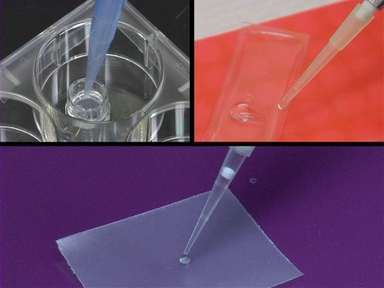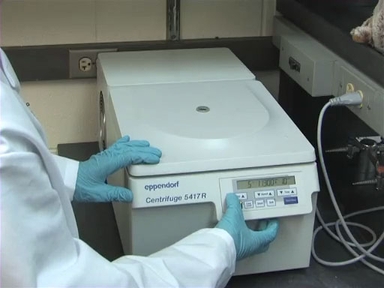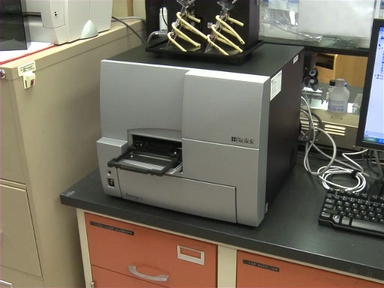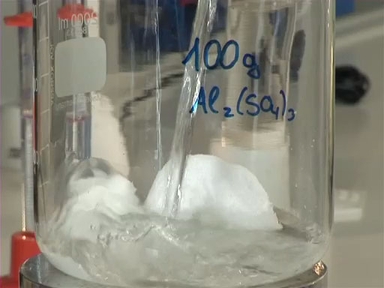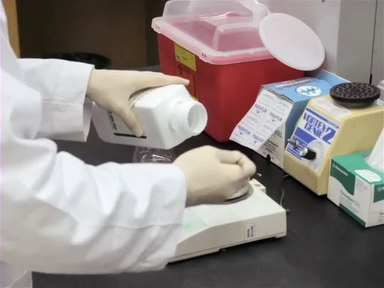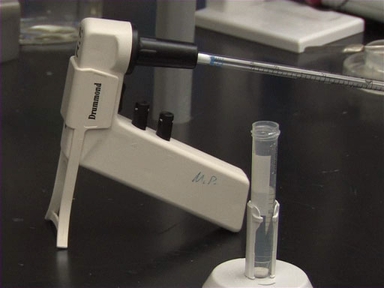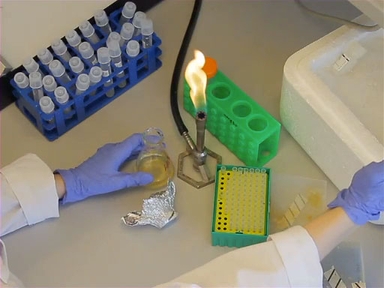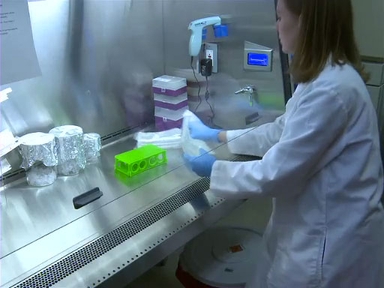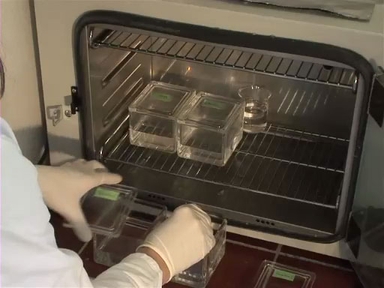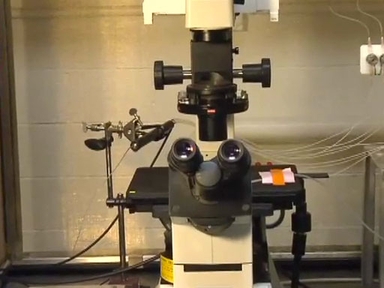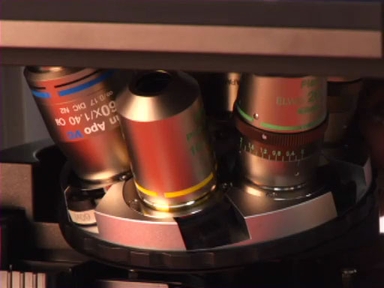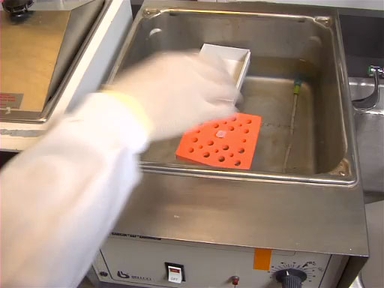The micropipettor is an important instrument used to precisely measure small volumes of liquid. This research tool, which can be found in numerous research laboratories across the globe, comes in several shapes and sizes. However, despite the variation amongst micropipettors, all of them work in a similar way to accurately measure microliter quantities of liquid. Micropipettors are used with disposable tips, that, like micropipettors, come in a range of sizes.
All micropipettors share the same basic components for aspirating and dispensing liquids. The plunger is found at the top of the pipettor and is used for drawing up or expelling liquid depending on the position to which it is depressed or released.
The volume adjustment dial is used to change to volume of liquid to be transferred.
The volume readout display is read from top to bottom. Depending on the micropipettor used the numbers reflect different orders of magnitude in your volume measurement. Here you can see a measurement for 370 microliters.
Disposable tips are loaded onto the bottom of the micropipettor.
The tip eject button and tip eject shaft work together to eject pipette tips when they need to be discarded.
The micropipettor family includes several members of varying sizes that transfer a precise range of volumes.
Here you can see the family lining up according to the volume ranges that they each can transfer. For example, Papa P-1000 delivers between 200-1000 µl, while the baby of the bunch, the P-2, transfers between 0.2-2 µl.
Each of the family members is recognizable by a number at the top of the plunger, and by color, which makes clear who they are and how much volume they can comfortably transfer.
Occasionally, other micropipettor relatives will show up for an experiment, like Uncle P5000, Auntie P100, and Cousin P10. Together, this extended family can assist in moving liquid from 0.2-5000 µl in volume.
To further ensure an accurate and precise transfer of liquid, different sizes of pipettes tips, often, but not always, are color-coded for ease of recognition and are used for different sizes of pipettors. With respect to volume transferred, white micropipettor tips typically transfer between 0.5-2.5 μl, yellow tips are for 1-200 µl, and blue tips from 200 to 1000 μl.
When using a micropipettor, first choose the instrument with the appropriate range for the volume you wish to transfer. Correct choice of pipettor could mean the difference between a successful or failed experiment.
To begin, adjust the dial to the desired volume. To increase the aspiration volume, turn the dial in a counterclockwise direction, passing the desired volume by a one-third turn, and then slowly decreasing to the final mark. To decrease the volume, turn the dial clockwise.
Keep in mind that these digits in the volume readout have different orders of magnitude depending on the micropipettor. For example, on the left, we see the P1000, reading 370 µl. There’s a zero in the thousands place, a 3 in the hundreds place, and a 7 in the tens place. On the right is the P200, displaying 159 µl with a 1 in the hundreds place, a 5 in the tens place, and a 9 in the ones place.
Once volume is set, select a tip.
Now, hold the micropipettor in an upright position with the narrow part of the body in the palm of your hand and the overhang over your index finger,
Using light pressure to depress the plunger approximately halfway to the first stop, or when you start to feel more resistance.
This action displaces air from the pipette tip.
Keeping the plunger depressed, immerse the tip between 1-3 mm into the sample. Smoothly release the plunger back into the rest position, wait one second for the liquid to move into the tip, and then remove the pipette from the sample.
When the plunger is released back into the rest position, the liquid is drawn into the vacuum created by the displaced air.
Inspect the tip to confirm the desired amount of liquid was drawn up and that the tip contains no air bubbles.
When transferring the sample into the desired vessel, hold the micropipettor at a 10-45° angle against the inside wall of the receiving vessel. This will prevent bubbles from forming at the tip. To expel the liquid depress the plunger lightly to the 1st stop smoothly, to begin dispensing the liquid, and then, applying stronger resistance, depress the plunger all the way to the second stop to “blow out” the last bit of liquid from the tip.
Remove the tip completely from the vessel, and then release the plunger back to the rest position.
Now use the eject button to carefully discard the pipette tip into the appropriate receptacle. Pay attention to what you are doing, because ejected tips can act as projectiles and can potentially injure your fellow lab mates.
To keep micropipettors working well and preserve the internal volume adjustment mechanism, never turn the volume dial above or below the specific range of the micropipettor. You may break the instrument.
To avoid cross contamination among samples, change the tip after each volume transfer.
Operator consistency is important when working with micropipetters. A smooth plunger pressure will yield optimal experimental results. Finally, remember, to keep your micropipettors in top-performing condition, always store the instruments in an upright position when not they are not in use.
Now that we have covered the basic operation and principles of using micropipettors, let’s discuss some common laboratory applications for microvolume transfers as well as variations of this instrument.
Micropipettors are frequently used for transferring cell suspensions to culture plates for a variety of experiments.
In conjunction with specialized tips, micropipettors can be used to carefully load samples for analytical techniques, like DNA gel electrophoresis.
Micropipettors can also be used to mechanichally break up tissue, in order to obtain single cell suspensions.
Variants of the micropipettor, which operate based on air displacement, can also be found in the lab.
Repeater pipettes allow serial pipetting of smaller volumes after an initial aspiration of a larger volume of solution. The pipettes are really useful for transferring the same volume of sample to a large number of receptacles.
Multichannel pipettes are usually used to transfer volumes in the 20-200 μl volume range , and are helpful for loading entire rows of 96 well plates.
You’ve just watched JoVE introduction to micropipettors.
In this video we reviewed: what a micropipettor is and how it works, how to aspirate and dispense a liquid volume sample, some safety precautions, and different applications of your micropipettors. Thanks for watching and remember pick the right pipette for your experiments.
